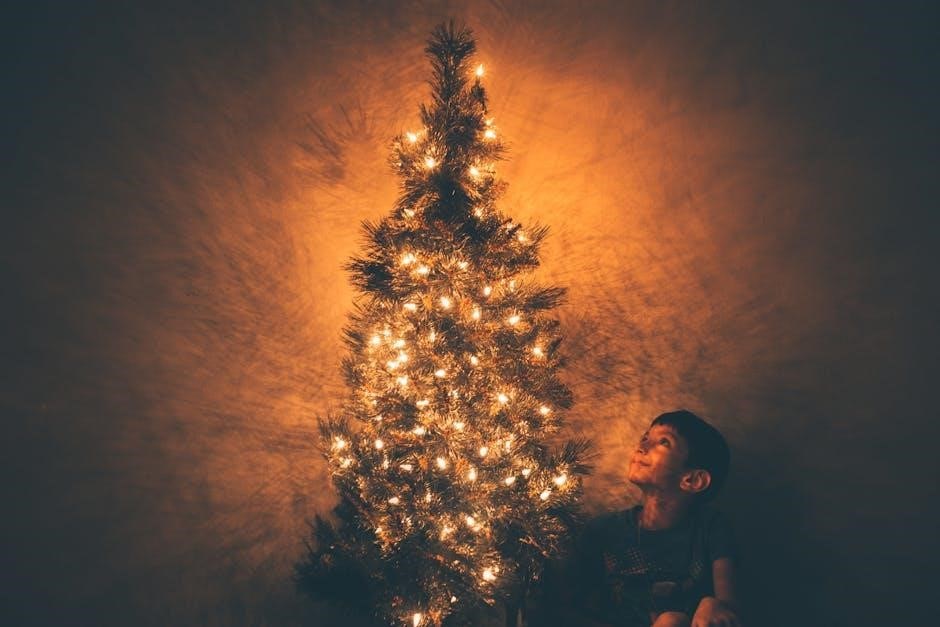
The Egyptian pantheon is a complex hierarchy of gods and goddesses, with a vast family tree connecting deities like Ra, Isis, and Osiris. The Ennead and Ogdoad represent key divine groups, shaping ancient Egyptian religion and culture through their interconnected roles and myths.
Overview of the Egyptian Gods and Their Significance
The Egyptian gods were central to ancient Egyptian religion, embodying natural forces, abstract concepts, and human ideals. Each deity had distinct roles, such as Ra as the sun god or Isis as a protector, influencing culture, art, and daily life. Their stories and symbols explained phenomena like creation and the afterlife, while their human-like traits and supernatural powers made them relatable yet awe-inspiring. The pantheon evolved over millennia, reflecting societal changes and political shifts, with gods like Amun rising to prominence. Their significance lies in their enduring impact on Egyptian identity and worldview.

The Origins of Egyptian Gods
The Egyptian gods emerged from creation myths, originating around 3100 BC, reflecting early religious beliefs and evolving over millennia as key figures in Egyptian society and worship.
Creation Myths and the Emergence of Deities
Egyptian creation myths describe the emergence of gods from primordial chaos. Atum, the sun god, rose from the Nun, creating Shu and Tefnut, embodying air and moisture. These deities gave birth to Geb (earth) and Nut (sky), forming the cosmic structure; The Ennead, led by Atum, and the Ogdoad, representing primordial forces, were central to these myths. Ptah, another creator god, was revered for crafting the world through speech and craftsmanship. These myths not only explained the world’s creation but also established the gods’ roles in maintaining cosmic order and the balance of Ma’at, reflecting the Egyptians’ deep understanding of the universe and its harmony.
Principal Egyptian Deities
The principal Egyptian deities include Ra, the sun god; Isis, the mother goddess; Osiris, the ruler of the underworld; Anubis, god of mummification; Horus, the sky god; and Ptah, the creator god. Each deity holds distinct roles and symbols, central to Egyptian mythology and worship.
Key Gods and Goddesses in Egyptian Mythology
The Egyptian pantheon includes iconic deities such as Isis, the mother goddess of magic and fertility; Osiris, the ruler of the underworld; and Ra, the sun god embodying kingship. Horus, the falcon-headed god of the sky, represents kingship and protection, while Anubis, with his jackal head, governs mummification and the afterlife. Ptah, the creator god, and Thoth, the ibis-headed god of wisdom, also hold significant roles. Each deity symbolizes aspects of nature, society, and human experience, shaping the intricate tapestry of Egyptian mythology and religion.
The Egyptian Gods Family Tree
The Egyptian gods’ family tree centers around the Ennead and Ogdoad, with Ra as the sun god ancestor. Key deities like Isis, Osiris, and Horus form core connections, illustrating divine relationships and cosmic order.
Understanding the Ennead and Ogdoad
The Ennead and Ogdoad are foundational groups in Egyptian theology. The Ennead, led by Ra, includes nine gods embodying creation and cosmic order. The Ogdoad, with eight primordial deities, symbolizes chaos and the creation process. These groups form the backbone of the Egyptian pantheon, illustrating the evolution from chaos to order and the interconnectedness of divine beings. Their roles in creation myths and cosmic maintenance highlight their significance in ancient Egyptian religion and the structure of the divine family tree.
Mythological Stories of the Egyptian Gods
Egyptian myths feature epic tales like Osiris’s resurrection and Horus’s battle with Seth, showcasing divine struggles and the cyclical nature of life, death, and resurrection.
Major Myths and Their Impact on Egyptian Religion
The myths of Osiris, Isis, and Horus shaped Egyptian religious beliefs, emphasizing themes of resurrection, justice, and divine order. The story of Osiris’s resurrection symbolized the cyclical nature of life and death, influencing funeral rites and the concept of the afterlife. The battle between Horus and Seth represented the eternal struggle between order and chaos, reinforcing the importance of Ma’at, or balance. These myths were central to rituals, temple practices, and the pharaoh’s divine legitimacy, embedding themselves deeply into Egyptian culture and daily life.
Symbols and Attributes of Egyptian Gods
Egyptian gods were often depicted with distinctive symbols reflecting their roles. Ra, the sun god, wore a solar disk, while Anubis, the jackal-headed god, symbolized mummification. Isis, embodying motherhood, was often shown with a throne, representing her protective nature. These symbols, such as the ankh for life and the was sceptre for power, were central to their worship and artistic representation.
Understanding the Roles and Symbols of Each Deity
Egyptian gods were often depicted with specific symbols that reflected their divine roles. Ra, the sun god, was associated with the solar disk, embodying light and creation. Isis, the mother goddess, was represented with a throne symbol, signifying protection and royalty. Anubis, the god of mummification, was depicted with a jackal’s head, linking him to the afterlife. Each deity’s symbols, such as the ankh for life or the was sceptre for power, highlighted their unique attributes and responsibilities. These symbols were central to their worship and artistic representation, reinforcing their divine influence over natural phenomena and human affairs.

The Influence of Egyptian Gods on Culture
Egyptian gods profoundly shaped culture, inspiring art, religion, and daily life. Their myths and symbols influenced pharaonic rule, architectural designs, and societal norms, leaving a lasting legacy.
Religion, Art, and Daily Life in Ancient Egypt
Ancient Egyptian religion deeply influenced art, with gods depicted in human and animal forms, symbolizing divine powers. Temples served as communal spaces for worship, and priests maintained rituals, believing gods controlled natural phenomena. Artworks often featured symbolic attributes, such as Anubis with a jackal head, emphasizing their roles in the afterlife. Daily life was guided by religious beliefs, shaping agriculture, festivals, and social norms. The pantheon’s influence extended to pharaonic rule, reinforcing divine authority and cultural identity, making Egyptian gods central to every aspect of society.

Regional Variations in Egyptian Religion
Egyptian religion varied by region, with local cults and deities dominating specific areas. Thebes worshipped Amun, while Memphis revered Ptah, reflecting diverse divine influences across Egypt.
Local Cults and National Deities
Local cults played a significant role in shaping Egyptian religion, with each region venerating its own deities. Thebes, for instance, worshipped Amun as a national god, while Memphis honored Ptah. These local cults often elevated their gods to prominence, blending regional traditions with broader Egyptian mythology. National deities like Ra and Isis gained widespread reverence, but local gods retained importance in their specific areas. This duality allowed for a rich, diverse religious landscape, with festivals and rituals often centered around these deities, reflecting the intricate balance between local and national worship in ancient Egypt.

Evolution of Egyptian Religion
Egyptian religion transformed from early animism to complex polytheism, with gods evolving from nature spirits to multifaceted deities. The shift from local cults to a unified pantheon reflected societal changes, while periods of monotheism, like Atenism, briefly redefined worship before returning to traditional practices, showcasing a dynamic, adaptive religious landscape.
From Animism to Monotheism
Egyptian religion evolved from animism, where natural elements were revered as spirits, to a complex polytheistic system with defined deities. Early beliefs in nature spirits transitioned into worshipped gods like Ra and Isis, embodying cosmic forces. The New Kingdom saw monotheistic tendencies, notably Akhenaten’s Atenism, which centralized sun worship. However, traditional polytheism resumed post-Akhenaten, blending old and new practices. This dynamic shift reflects Egypt’s theological adaptability, merging local cults with universal concepts, while maintaining a rich, evolving spiritual framework that influenced daily life, art, and pharaonic authority across millennia.
The Egyptian pantheon’s legacy endures, influencing modern culture, art, and spirituality. Their intricate family tree, spanning from Ra to Isis, reflects a rich, evolving theological framework that shaped ancient Egypt’s identity and continues to captivate the world today.
Legacy of the Egyptian Gods in Modern Times
The Egyptian gods’ influence persists in modern culture, inspiring art, literature, and film. Their iconic imagery, such as Anubis and Isis, appears in media like “Gods of Egypt” and MCU movies. Academic interest in their family tree and mythology continues to grow, with resources like “Egyptian Gods Family Tree PDF” aiding research. Their legacy is also seen in spiritual practices and symbolism, proving their timeless appeal and cultural significance. This enduring fascination highlights the gods’ lasting impact on human imagination and understanding of the divine.